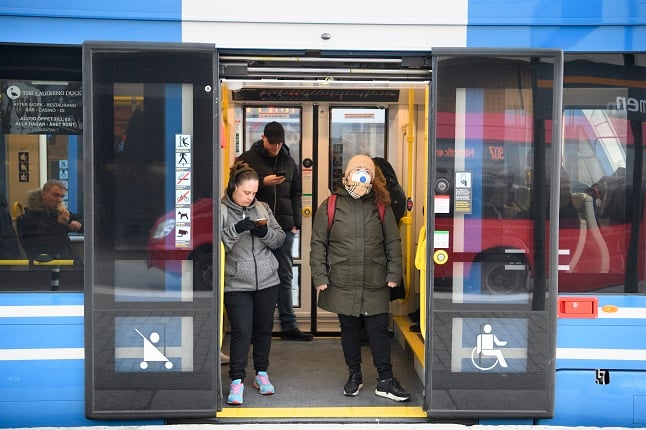Most transport renovations take place during Sweden's long summer holidays, partly because there are typically fewer commuters at this time and partly because the work is easier during longer, clearer days.
But with more people likely to stay in their hometown this summer due to global travel restrictions and the risk of infection of the coronavirus, this year the disruption could have particularly negative consequences.
From June 13th, people without any cold- or flu-like symptoms are able to travel freely within Sweden, but the advice from the Public Health Agency remains to limit use of public transport as much as possible. That's especially relevant in more densely populated cities. Stockholm public transport operator SL continues to ask all residents to travel “only if you must”, and to avoid travelling during rush hour if at all possible.
“The corona pandemic makes this summer special,” said SL traffic director Fredrik Cavalli-Björkman. “Travel by public transport always goes down after Midsummer, but nevertheless it can be difficult for SL passengers to keep the recommended distances from each other, especially at Gullmarsplan. Our request remains not to use public transport, and to avoid rush hour if you have to travel with SL.”
If you find yourself needing to travel, these are the changes you'll have to be aware of.
-
The words and phrases that will help you survive your commute in Sweden
- The Local's ultimate guide to exploring Sweden by train
Tunnelbana
Stockholm's subway line is set to get significantly extended, and work on that project means the busy stretch between Globen and Gullmarsplan on the green line will be closed for eight weeks between June 22nd and August 16th.
Gullmarsplan is a transport hub and one of the city's busiest tunnelbana stations, so a few different measures will be taken to avoid congestion. People will be able to switch to the tvärbanan (tram) which also runs between these two stations and will be strengthened by more frequent departures, and there will also be extra departures on the other two green line routes, towards Farsta and Skarpnäck, during rush hour.
Things like vending machines will be removed at Gullmarsplan to create more space, and the following bus lines will get extra departures: line 143 (Älvsjö-Hökarängen), line 173 (Skarpnäck-Skärholmen), line 195 (Gullmarsplan-Hagsätra weekend night bus), line 163 (Älvsjö-Dalen), line 195 (Högdalen-City during day time).
Tvärbanan
The closure of the tunnelbana between Globen and Gullmarsplan might make the tvärbanan route busier, and in the north of the city, the tvärbanan will be closed between Johannesfred and Solna from July 5th to July 31st. Passengers along that route will need to take a replacement bus between Alvik and Solna instead.

Photo: Henrik Montgomery/TT
Regional trains
If you're leaving Stockholm by train to travel elsewhere in Sweden, check your ticket and timetables carefully.
The regional train track (which is separate from the pendeltåg track) between Stockholms Central and Stockholms Södra is closed over summer due to planned renovations. This will take place between June 22nd and August 17th.
Customers therefore need to travel from either Stockholm Södra or Flemingsberg on many regional routes going south from Stockholm, rather than the usual central train station. However, the Stockholm Central station remains open and some trains will continue to arrive and depart from there, including many northbound trains. Make sure you've checked your ticket and/or the SL website carefully.
Commuter trains
Travellers on the pendeltåg lines should be aware of the disruptions outlined above, since this will mean more passengers at Stockholms Södra and Flemingsberg stations, and busier trains on this stretch. SL has increased trains on this stretch by 33 percent to help avoid crowding, although fewer long-distance train travellers are expected this summer.
Apart from that, there is just one change to be aware of. The route between Sundbyberg and Jakobsberg will not be running between July 4th and 26th.
During this time, passengers will need to take replacement buses connecting to the tunnelbana and then use the blue tunnelbana line, which will have extra departures.
And it's important to know that, although the pendeltåg doors open automatically through the rest of the year, during summer you need to press the button to open them (this is in order to help maintain a comfortable temperature onboard). The exceptions to this are Stockholm Södra, Stockholm City, Stockholm Odenplan, and Arlanda. Don't miss your stop!
Buses
In Stockholm, SL continues to request that passengers board using the rear doors only, and wait for the next bus rather than board a crowded one.
Archipelago ferries
One of the main companies which operates ferries to the archipelago islands, Waxholmsbolaget, is operated by SL and therefore the recommendation to make only essential journeys applies for these boats too.
Capacity on the boats is limited in order to ensure social distancing can be maintained onboard. During the coronavirus outbreak, priority for boarding will go to crew members and island residents, and the crew may deny boarding to other passengers if the boats get too full, or if you are showing symptoms of illness. It's also temporarily not possible to make bookings for large groups.



 Please whitelist us to continue reading.
Please whitelist us to continue reading.
When an assassination is carried out by espionage agencies, then it’s very difficult to find the culprits. Mainly because the professionals do research and analysis before it’s carried out. This one too, may be an assassination by any such agency.